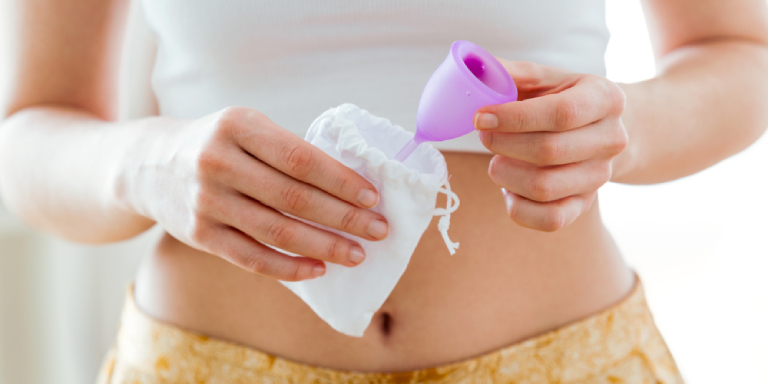
How to… use a menstrual cup

Menstruation is and always will be a typical female thing, and we can talk endlessly about it. In addition to pads, tampons or free bleeding, using a menstrual cup has also gained popularity in recent years. The menstrual cup is a silicone cup that’s inserted vaginally, where it can then collect your blood. It’s a fairly ‘new’ way of physically dealing with your period. But how does a menstrual cup actually work, and what should you look out for? Read on!
What’s a menstrual cup?
The menstrual cup is a silicone cup that’s inserted vaginally during menstruation. Unlike a tampon, which absorbs menstrual blood, the cup will collect the blood. On average, a cup can be left inserted for 12 hours. After removal, the cup can be rinsed and cleaned, and then reinserted.
Did you know… that a menstrual cup is safer for your vagina and more environmentally friendly than tampons?
Different types and sizes
There are various menstrual cups on the market, all made of safe materials. In addition to different brands, there are also different sizes for sale. In general, the smaller sizes are recommended for women who have not yet given birth. Women who have already had children can purchase a slightly larger size – this has to do with the softness and flexibility of the cervix. Besides differences in size, soft and firm cups are available too:
- Soft cups are especially recommended for women with sensitive vaginas or weaker pelvic floor muscles.
- Firm cups are good for women with stronger pelvic floor muscles. Softer cups may not unfold and position as well for these women.
- Small menstrual cups are particularly suitable for young girls, women who are not yet sexually active, slimmer women, women with light periods, and for women who have not yet given birth vaginally.
- Larger sizes are suitable for women who usually have heavy periods and/or have given birth vaginally.
The advantages and disadvantages of a menstrual cup
Using a menstrual cup has a lot of advantages. Besides the fact that it’s reusable for up to 5 to 10 years, the material of the cup is very friendly to your vagina. The silicone material is easy on the vaginal mucous membranes, which means that the vaginal environment is not disturbed. This also reduces the risk of nasty infections, something that’s more likely to happen when using tampons and pads.
Other benefits
- The cup can stay inserted for up to 12 hours, so feel free to leave it in overnight.
- It’s cheaper in the long run, as you can use the cup for 5 to 10 years. That saves a lot of money that you’d otherwise spend on tampons or pads.
- It’s environmentally friendly.
- It can also be used when doing sports, swimming, or going to the sauna.
Also read: Natural pleasure with these vegan sex toys
Disadvantages
Despite its many advantages, there are some disadvantages to using a cup. This is especially true when the cup is used incorrectly. Incorrect removal of the cup can result in the risk of prolapse. Prolapse means that the uterus and/or other organs in the pelvic area sag, as they’re no longer properly supported by the pelvic floor muscles. Prolapse can cause unpleasant symptoms.
Did you know… that a woman uses an average of 11,000 tampons or pads in her lifetime? Using a cup will be a lot more environmentally friendly as it creates much less waste.
However, prolapse doesn’t just happen overnight. In particular, women who are already at risk of prolapse or who already have slight prolapse should use a cup with caution. This also applies to women who have recently given birth or to overweight women. This is because a menstrual cup creates a vacuum. When removing the cup, the vacuum should be broken carefully before pulling the cup out.
Also read: The effect of your menstrual cycle on your body and behaviour
How do you use the cup?
This is how you insert the cup:
- Make sure your hands are clean. Wash your hands!
- Fold the menstrual cup so that it can be inserted properly.
- Get into a comfortable position and make sure you can relax. You can sit, squat, lie down with your knees raised – whatever feels good to you.
- Insert the cup. You do this by holding the folded cup with one hand and spreading your labia with your other hand. Insert the cup all the way in, including the stem: the cup will unfold by itself. The cup does not have to be placed as far in as a tampon. It will stay low in the vagina, where it can create a tight seal.
- Turn the cup carefully. Does it turn easily? Then you’ll know for sure that it has unfolded properly.
How to remove the menstrual cup:
- Wash your hands again.
- Return to a comfortable position.
- Apply some pressure or press gently so that the cup comes down a little. Then lightly squeeze the cup to break the vacuum.
- As soon as the vacuum is broken, you can carefully remove the cup by the stem.
Do’s and don’ts
It may take some practice in the beginning. Take your time to get comfortable with inserting and removing the cup. There are several things to bear in mind here:
- Never pull the cup out directly by its stem. Make sure that the vacuum is broken first.
- Store the cup at room temperature in a dry place in a storage pouch. A pouch is often supplied with the cup. Make sure that the cup is not hermetically sealed: the cup needs to be able to ‘breathe’.
- Sterilise the cup once or twice during your cycle by placing it in boiling water or soaking it in a vinegar solution for 5 minutes.
- Empty the cup when it’s full, then rinse it with cold water and then with lukewarm water. Avoid using soaps.
- You should not feel the cup. Do you feel something? Then you can gently push it a bit higher and adjust the position until it feels comfortable.
- While wearing the cup, it shouldn’t leak (or just a drop, at most). Do you notice that it’s leaking? Perhaps you didn’t insert it properly. Try a different folding technique. Is it still leaking? Then you’re probably using the wrong size.
- You can cut off the stem if it’s irritating.
Also read: Sex, dating and love: these are the trends for 2022!
Are you already using a menstrual cup? Or are you ready to start using one? Let us know in a comment!










Respond or ask a question
0 comments